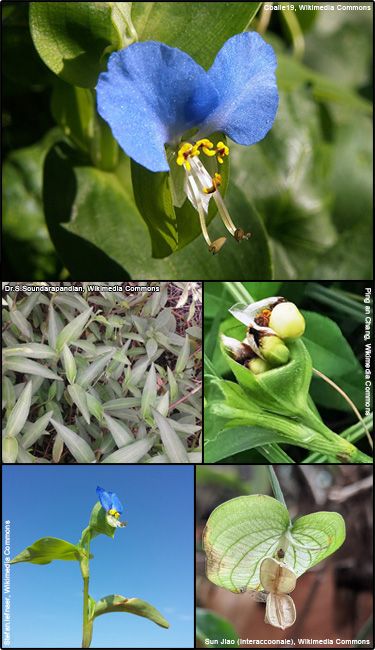Asiatic dayflower (Commelina communis)
 Description: Plant gets it name from its' flowers only bloom for one day.
Description: Plant gets it name from its' flowers only bloom for one day. Habit: Erect to spreading summer annual.
Leaves: Alternate, oblong to lance-shaped, 2-4 in. long, gradually tapering to a point, parallel veins, smooth margins. Clasp the stem and forming conspicuous basal sheaths.
Stems: Erect to prostrate, spreading, numerously branched, rooting at the nodes; thick, fleshy and swollen at nodes.
Flowers: Attractive, each flower consists of two large, bright blue petals at the top and a single, small, white petal below. Green, leaflike bract. Occurring at the ends of long flower stalks. Open only for one day.
Fruit and seeds: Two-celled capsules containing brown to reddishing, wrinkled seeds.
Habitat: Native to Asia. Can be found growing in moist, shady forest edges, wet crop fields, orchards, ditches and roadsides.
Reproduction: Primarily by seed but can reproduce vegetatively during the summer months.
Similar species: Native slender dayflower (Commelina erecta).
Monitoring and rapid response: Poorly controlled by glyphosate. Many commonly used herbicdes did not show much success with controlling this species. Credits: The information provided in this factsheet was gathered from MSU Plant & Pest Diagnostics and Purdue University Weed Science.
Individual species images that appear with a number in a black box are courtesy of the Bugwood.org network (http://www.invasive.org).Individual photo author credits may not be included due to the small display size of the images and subsequent difficulty of reading the provided text. All other images appear courtesy of Google (http://images.google.com).
Common Name: | Asiatic dayflower |
Scientific Name: | Commelina communis |
Family: | Commelinaceae (Spiderwort) |
Duration: | Annual |
Habit: | Herbs |
USDA Symbol: | COCO3 |
